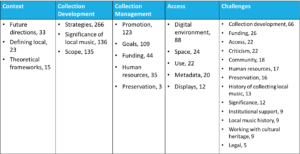by Carolyn Doi
Education and Music Library, University of Saskatchewan
This post builds off of an earlier one by research assistant Veronica Kmiech, which outlines the process for searching and identifying literature on the topic of how practitioners in cultural heritage organizations manage local music collections.1 I have worked with Veronica since summer 2016 on this project, which led to a thematic analysis of the literature seeking to better understand the professional practices implemented and challenges faced in managing, preserving and providing access to local music collections in libraries and archives.2
Using NVivo to facilitate the thematic analysis in this project was ultimately extremely helpful in organizing and managing the data. With over fifty sources to analyze in this review, the thought of doing this work manually seemed daunting.
Thematic analysis typically encompasses steps which take the researcher from familiarization of the data, through development of codes and themes, and finally to being able to tie these themes to the broader picture within the literature.3 NVivo becomes particularly useful at the stages of coding and theme development.
During the coding phase, NVivo will help save descriptions, inclusion, and exclusion criteria for each code. These are fairly easy to change as needed, being able to see an overview of the codes you are working with is definitely helpful, and it is easy to create hierarchies within the node sets. Once code labels are identified, coding the dataset involves (a lot!) of highlighting and decisions about which node(s) to assign to that piece of text. Adding new nodes is fairly simple, as there will likely be themes that come up throughout the coding process. Word to the wise: coding is made easier with NVivo, but the software doesn’t do all the work for you. Schedule extra time for this portion of the research.
During the phase of theme development and organization, NVivo made it quite easy to sort nodes into broader themes. In practice, this process took a few revisions in order to fully think through how and why nodes should be sorted and organized. The software has some features that assist with finding significance within the themes including ability to make mind maps, charts, and word frequency queries. After this process, I identified five broad themes were identified within the literature, some with as few as three associated nodes, and some with as many as thirteen (fig. 1).

Figure 1: Themes and node hierarchy
Following the development of this hierarchy, I went back into the literature, to find examples of how each theme was applied and referred to in the literature. When presenting the analysis portion, these examples were helpful in illustrating the underlying narrative.
This example (fig. 2) shows nodes found within the theme which brings together data on the theme of why practitioners choose to collect local music.

Figure 2: Goal and Objective theme
To better illustrate the significance or application of these concepts, I used quotes from the literature as examples. This excerpt works particularly well as an illustration of why heritage organizations might choose to collect local music, why it may present challenges, and why it can be considered unique:
The Louisville Underground Music Archives (LUMA) project was born of the need to document this particular, and important, slice of Louisville’s musical culture. …from a diverse community of bands and musicians, venue and store owners, recording studios and label managers, and fans to maintain the entire story from a broad range of perspectives.4
Pulling quotes such as this one helped me to build a narrative around the themes I’d identified, and serve to provide a gateway into the literature being analyzed.
The process of analyzing the data this way provided me with a rich resource on which to build the literature review, and a unique map of what the literature represents. While NVivo has some flaws and drawbacks (price, switching between operating systems, and working collaboratively were notable obstacles), the benefits outweighed them in the end (quick learning curve, saves the time of the researcher, assists considerably with organization of data and thematic synthesis). I highly recommend NVivo as a tool to keep in your back pocket for future qualitative analysis projects.
1 “Locating the local: A literature review and analysis of local music collections.” https://words.usask.ca/ceblipblog/2017/01/17/lit-review-local-music-collections/
2 Results from this analysis were recently presented during the 2017 annual meeting of the Canadian Association of Music Libraries (CAML) in Toronto, ON in a paper titled Regional music collection practices in libraries: A qualitative systematic review and thematic analysis of the literature.
3 “About Thematic Analysis.” University of Auckland. https://www.psych.auckland.ac.nz/en/about/our-research/research-groups/thematic-analysis/about-thematic-analysis.html
4 Caroline Daniels, Heather Fox, Sarah-Jane Poindexter, and Elizabeth Reilly. Saving All the Freaks on the Life Raft: Blending Documentation Strategy with Community Engagement to Build a Local Music Archives. The American Archivist, Vol. 78, No. 1 (2015): 238–261.
This article gives the views of the author(s) and not necessarily the views of the Centre for Evidence Based Library and Information Practice or the University Library, University of Saskatchewan.

